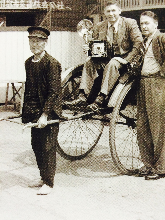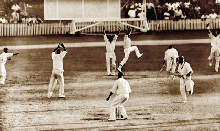Ron Lovitt


Ron Lovitt was the first photographer to become Pictorial Editor at the Age. As a working photographer, he went on two major international assignments; one to Japan in 1951-52 and the other to New Guinea in 1956-57.
His best known photograph has gone down in history as one of the greatest in the history of Australian sports photography. Ron Lovitt took the photo of the last wicket, off the last ball, in the famous tied test against the West Indies at the Brisbane Cricket Ground in December 1960. Journalist, Tim Lane, describes how Lovitt managed to get the shot.
Of course, there were no automatic, digital cameras back then, and Lovitt began the final day armed with 36 negatives. By the start of the last eight-ball over, he had one left. Next to him, Bob Barnes of Brisbane's Courier Mail still had six. They struck a deal to pool their resources and Barnes would "go first".
After six balls of mayhem, the last of which might have ended the match, Barnes' negatives were gone. Lovitt still had his last shot in the locker. Former long-time Age photographer Bruce Postle says Lovitt later told him he could see history unfolding with every ball but just closed his eyes and waited.
On the scheduled second-last ball of the match, Lindsay Kline tucked Hall down on the leg-side and he and Meckiff took off for the winning run.
As Meckiff lunged at the crease, and Solomon fired from side-on to the stumps, Lovitt pulled the trigger. The result is perhaps the most significant, and greatest, cricket photo ever taken. Amid the evocatively long shadows, the wicket has just been broken, the ball is still in shot. To the extreme left of frame you see Solomon following his immortal throw to the stumps. To his right is an excitable, but spent, Hall.
At the batting end are the celebrating Sobers and leaping Kanhai. To the right of frame, Kline looks back apprehensively as Meckiff's thrust falls agonisingly short.
Most poignant of all, though, is the presence at the other end of the pitch. With all hell breaking loose around him, with his excitable men at breaking point, the great leader – Worrell – has ensured the bowler's end stumps are guarded, on the off-chance Solomon's throw might have come that way. The symbolism of him there, vigilant, dotting the last "i", crossing the last "t", never fails to send a shiver through me. It is commitment and cool personified.
Speaking of cool, Postle says Lovitt's judgment and self-discipline that day was "the coolest effort by a photographer I have ever heard about".
Lovitt died working at his desk.
Sources:
- Kathleen Whelan, Photography of the Age: Newspaper Photography in Australia, Brolga Publishing, Melbourne, 2014 pp 62-65.
- Tim Lane, 'A Test in Timel',Sydney Morning Herald, 5 December 2010.http://www.smh.com.au/sport/cricket/a-test-in-time-20101204-18ktb.html